On the night of June 30th 2023, I was browsing /a/, until I stumbled upon a particular thread, it was a “daily XXX chapter” thread about a series I’d never heard of before, titled “GA Geijutsuka Art Design Class”.
Being a fair enjoyer of Slice of Life and 4komas, I decided to give it a try. I looked the series up and found out it was completed, which convinced me to read it all the more, as I was already following enough ongoing series as-is.
Nineteen days later, I finished the manga, and in this blogpost, I will chronologically recount my reading experience, and my thoughts on the series as a whole. But well… considering I went through the trouble of writing an entire article, you can pretty much guess already that those thoughts are very positive ones.
Let’s get started then.
“This is pretty cute, and instructive too!”
During volume one, the read was pleasant, though I was not fully immersed in it yet.
As I got to the end of volume two, I reached the afterword, which reads.
“People generally agree (?) that these four-panels comics take an excessive amount of energy to read.
GA: GEIJUTSUKA ART DESIGN CLASS, Volume 2
Thank you for reading it
I’d be happy if you could nibble on the art knowledge without trusting it too much”
My initial reaction was along the line of “heh, true”: after all, I do agree that one Slow Start chapter takes me longer to read than one Chainsaw Man chapter, despite the former being only 7 pages long.
But then, my mind started wandering on that second statement, which proved to be harder to listen to than I expected… because I was really enjoying those explanations.
Despite the warning (reiterated in later volumes), it is still undeniable that you can learn a lot of general art knowledge from this manga. The author never hesitates to turn dialog into a surprise art lesson.
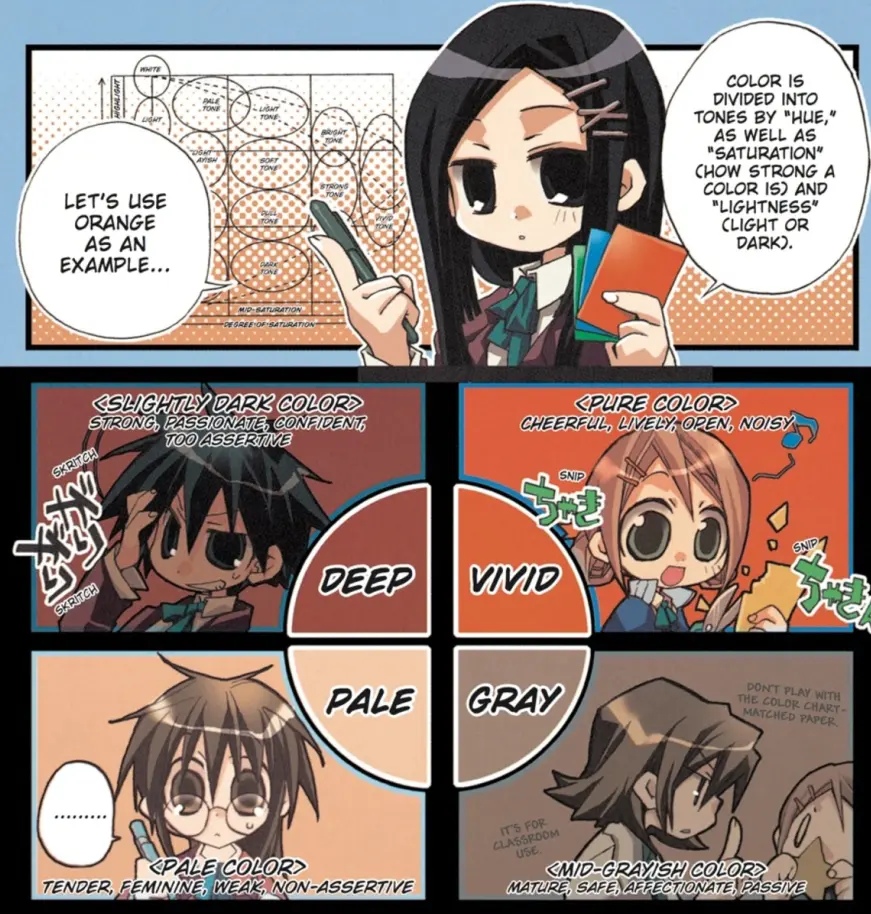
While it could sound like this ruins the immersion, those technical bits do the opposite: art occupies a huge place in the girls’ lives, the way it is explained feels natural and reads like classmates teaching each-other stuff. It really emphasizes the fact that they are actively learning art:
Ayanoi High School is more than just a setting for the story to unfold in: it is not simply an plot device to have many characters interact with each other, but a shared reality that the entire cast experiences, enjoys, and struggles against, each to a different degree.
All the knowledge the author shares shows a deep passion for art, and make this manga really stand out in the “school life” genre.
“This is very colorful! And… brown?”
As I kept on reading, I grew more and more conscious of one small detail: the color pages… there’s a lot of them.
Part of me understood that having color is convenient when you want to explain stuff about art, but seriously… there really is a lot of them! More than I’ve seen in any other kirara for sure!
Eventually, I reached this page.

That second panel (bottom right) stuck with me through the rest of my reading experience, and made me realize how “brown” this manga is.
The uniforms are a deep pleasant brown-ish red, wood is heavily used in the school’s architecture/furniture, and even the brightest walls still have a beige tint. The manga radiates an overwhelming feeling of warmth which didn’t fail to soothe me as I read.
Later, I heard from a friend that the author did work for JRPGs, which might have had a small influence on the style and choice of colors.
“Hm…?”
The more I kept reading, the more I had that feeling of:
“hm?”
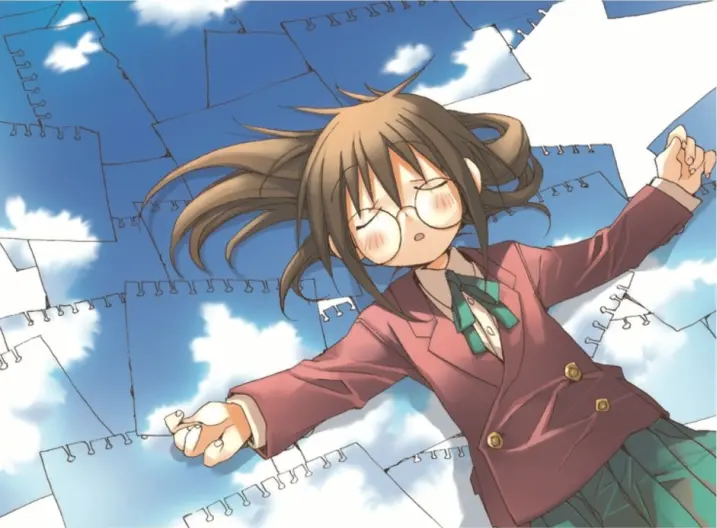
“hm?!”

“hmmmm?!!!”

This is not a feeling of “witnessing a life-changingly-beautiful picture”, but more like “oh hey that’s neat”, a conscious acknowledgement, upon seeing a detail, that someone went the extra mile for the sake of quality.
This is not a feeling I’m unfamiliar with, after all, it’s fairly common for artistic media to occasionally overdeliver. What really surprised me though, was how often I had these moments.
These chapter illustrations are, to me, a highlight of this manga: because it’s an exploration of art, the author has full freedom on what she wants to draw in these spaces, and most often draws it with great care.
The girls are picking a plaster bust, how about we draw it from the bust’s point of view ?
The chapter is about model kits, so let’s draw a fully detailed one, with all its layers overlapping in great details . Why? Because it’ll look really nice!
Whenever a time period, or an artistic movement is described, you can be sure it’ll be accompanied by a nice little illustration, imitating the style as well as possible.
I won’t beat around the bush, I think the quality of the art is really good.
When I started reading, all I knew was that I was getting into an old kirara manga about art, I never imagined my expectations would be so consistently exceeded.
As someone who occasionally draws, it is very inspiring to see an artist doing their best on almost every chapter.
All form and all substance
While ripe with pretty pictures, the manga also managed to get me with its writing.
There are many different kinds of chapters:
- Some are shenanigans and goofing around.
- Some are about the students learning new techniques/styles in class.
- Some are focused on a character growing and understanding art/themselves better.
- Some focus on characters outside of the two main groups (first years/art club).
- Some tell two stories in parallel, which ends in those two groups almost crossing paths.
There are more but these examples can already give you an idea of how your read will not get boring. Many facets of art, character interactions, and school life, are being explored in each chapter.
Kisaragi chapters particularly stand out: they usually start with her being stuck on an assignment or a personal project, after she learns from other students, her teachers, or even herself, she manages to understand her shortcomings, and ultimately overcomes the challenge.
I found these chapters very captivating, Kisaragi’s journey made me want to root for her, and its resolution felt very satisfying
A long awaited reunion (heavy spoilers)
One recurring theme of this manga is the author constantly teasing the idea of the first years meeting the art club. A good deal of chapters end with them almost coming in contact, or them briefly interacting without much more coming out of it.
However, in the penultimate volume, the reader’s patience is rewarded: the art club is in a pinch, understaffed for their art exhibition during the school festival, that is until the main group of first years (all members of the go-home club) are brought in to give a helping hand.
During this short period, we get a glimpse of another world, one where both groups would’ve met earlier, had any of their previous close-call-encounters gone differently.
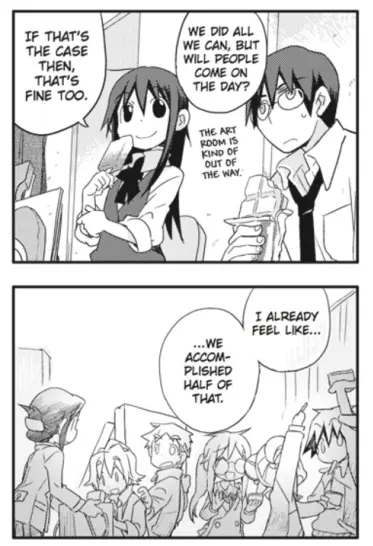
However, the school festival eventually ends, as does the school year.
Wrapping everything up (ultra heavy spoilers)
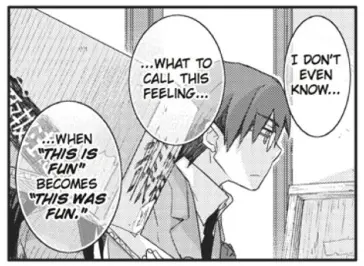
As many school-life manga do, GA has a graduation arc, which is incidentally where the author chooses to end the story. That is, however, not without tying up all of its loose ends with the final volume:
- Awara seizes the opportunity to study abroad in France (kino), following the footstep of the previous art club president whom she respects;
- The ship between Awara and Uozumi sinks, and Sotoma sensei also grows more conscious of and Usami sensei after an image change;
- Teachers have a few chapters of their own, sharing their motivations and drive for teaching;
- The main group also has talks about why they joined the school;
- Oomichi san (professor) has a final chapter of self-discovery, which dives into her (now revealed as) unintentional obsession with the color black and her inability to fantasize in her art;
- We get the most freakishly cute christmas chapter of all;
The final chapters primarily star Kisaragi, finally, in her final and most powerful moment of character development: on Awara’s graduation day, she asks to join the art club, effectively saving it from being shut down, and solving Awara’s internal struggle to either let it die, or to find someone suitable to pass the baton to.
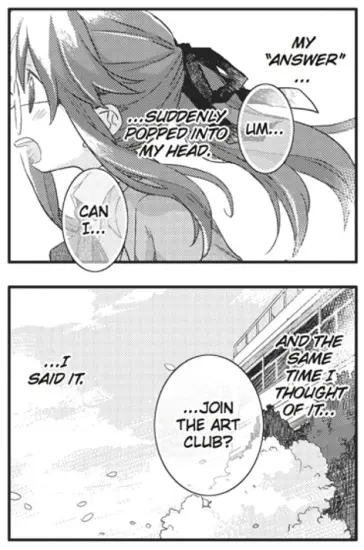
As her friends naturally follow her in the art club, she then applies to become the club president (a position uncharacteristically assertive for her archetype, her teachers remark). The club, which was on the verge of disappearing less than one year ago, experiences a renaissance with the (now second years) main group.
And life, at GA Geijutsuka Art Design Class, will go on…
Each person, on their separate way…
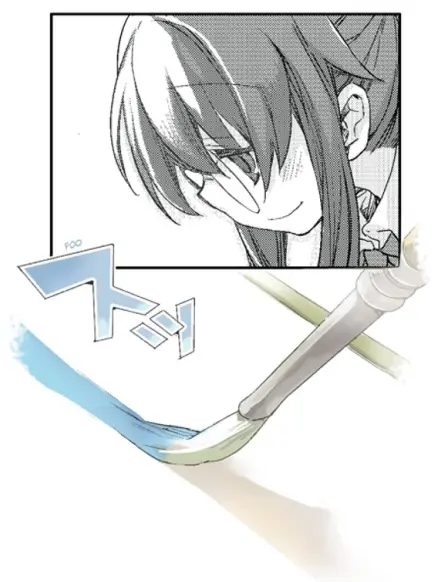
But all of them…
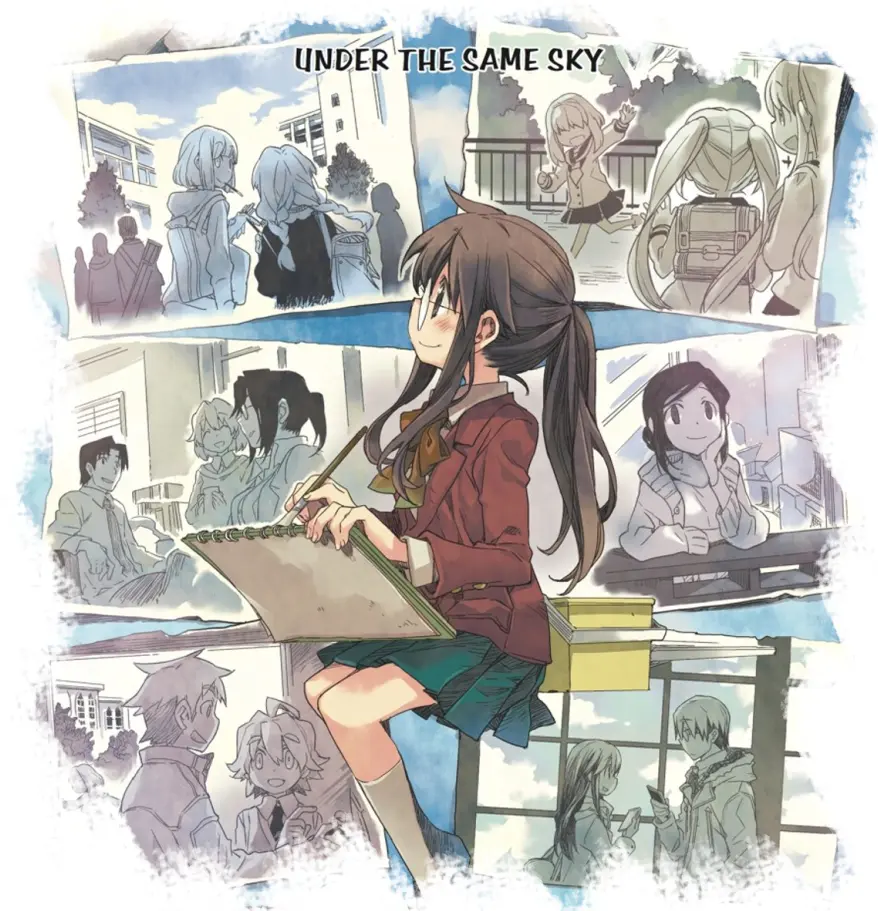
Conclusion
At the beginning of this article, I wrote about being a SoL and 4koma enjoyer. While I do have an undeniable bias toward this genre, I wouldn’t have written all of this for just about any manga.
Along with being an SoL, this manga has another characteristic that made it go from “I like this and want to talk about it with my friends” to “I love this and want to talk about it with the whole world”: it’s a manga about creative activities, which may have become my favourite subgenre.
It’s hard for me to fully articulate how strongly I feel about this genre, I feel like saying that I really really really love it would sound both stupid and accurate.
The process of creating something involves so many aspects of human relationships. You get to see the characters’ personal struggles being explored, their drive to improve, how they deal with skill and talent discrepencies among the group, how their personality may shine through their work, how they collaborate and compromise in order to work together, how the competitive aspects of their work will sometimes put them at odds with each other, how they deal with the conflicting feelings of being happy for their friends’ progress and jealous of it at the same time, how they may be afraid to be left behind, and how, despite all the joy, the passion, and the struggles that the path of creation brings, they do their best to stay united preserve their friendship. All of these emotions that you can feel whenever you’re following the path of art with people whom you treasure, I deeply relate to them, and really, really, really love them.
This is the reason why I read New Game! (a work-life kirara series) more than five times by now and will read it again.
This is the reason why Stella no Mahou (another kirara manga about making doujin games) was one of the best reading experience I’ve had in 2022, and something that I want to see fully translated someday.
This is the reason why I wrote this article.
When I finished New Game! I didn’t know if this genre had another manga in store that’d make me experience such feelings again, and then I found Stella no Mahou.
When I finished Stella no Mahou, I didn’t know if this genre had another manga in store that’d make me experience such feelings again, and then I found GA Geijutsuka Art Design Class.
So I will keep reading manga “where literally nothing happens”, I will look forward to the home-visit and beach chapters, and I will read dialog-packed 4-koma panels… because now that I finished GA Geijutsuka Art Design Class, I’ve decided to believe that Slice of Life as a genre will have another manga in store that will make me experience such feelings again.
Thanks for making it this far. I hope you’ll consider reading GA Geijutsuka Art Design Class.